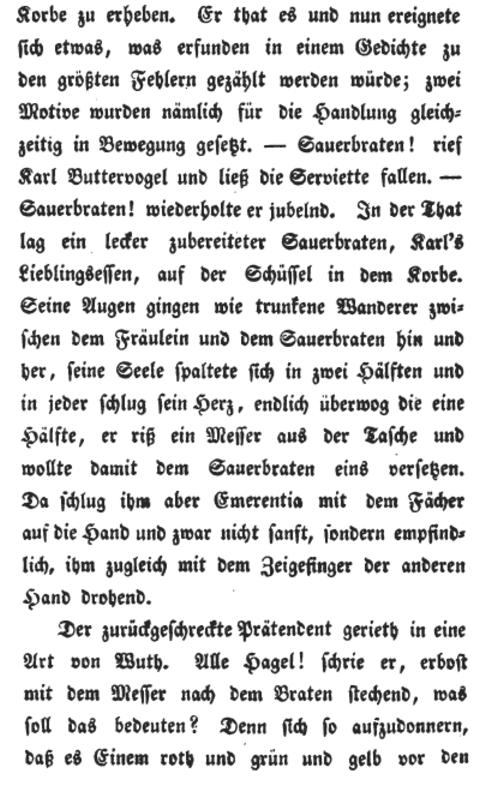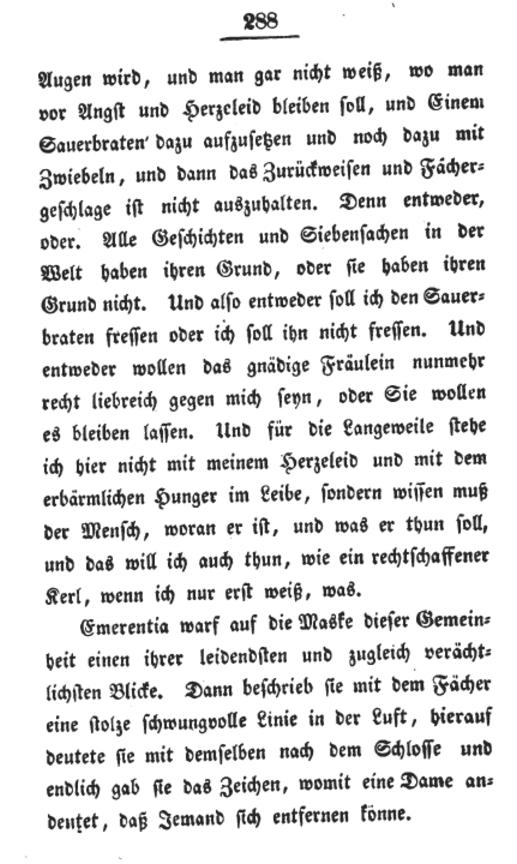 Historically Correct Traditional Recipes Historically Correct Traditional Recipes
Why it is important to be "historically correct".
Traditions and recipes, including correct processes and ingredients are
treasures which require time, effort energy and attention to
detail. Convenience and expense both in terms of finances and
labor do not enter into the equation. For holiday cookery especially
cookery is a religious sacrifice. Close adherence to the oldest
traditions is important. Declaring that whatever you happen to choose to
do is "traditional" is incorrect. Your DNA and ancestry do not enter in
to it. Food ways are learned and handed down. The challenge is
not to break the chain for convenience but to make the sacrifice and
investment of protecting and passing on the treasures. What you do
can be your contemporary or
recent tradition but it is not for example "traditionally German" or
traditionally "ethnic". To call something modern or American "German" or
"traditional" is lying.
At times ingredients or equipment may not be available.
These temporary adaptations are often perpetuated. Because of this
tendency of recipes and practices to drift. Maintenance of the tradition
requires occasional monitoring, research and correction back to the traditional
methods and recipes. Course correction insures that we are indeed
preserving and transporting a legacy from generation to geneation. This is no doubt
harder work and often more costly than simply proceeding with
adulterated practices and recipes however, the extra work and expense is
required . Preservation of food ways is priceless. By excavating the original recipes
from ancient texts we can help to make this process possible. This does
not mean that there can not be variation, but, only that it is
historical variation often based upon regional traditions that are
worthy of revival and preservation.
The General Process from Wikipedia
Preparation
A solid cut from the bottom round[ or rump is marinated for three or four days, or as many as 10, before cooking.
Red wine vinegar, wine, and/or water typically forms the basis of the
marinade, which also includes earthy aromatic spices such as peppercorns, juniper berries, cloves, nutmeg, and bay leaves and less commonly coriander, mustard seed, cinnamon, mace, ginger, and thyme. The marinade may also include vegetables such as onions, celery, and carrots.
The acidic marinade helps tenderize the meat (which is typically a
tougher cut) before it cooks. Buttermilk is also used as a marinade in
certain regional varieties.
It is frequently advised to marinate the meat in an earthenware, glass, plastic, or enamel
container rather than one made of metal, so the acidic marinade does
not react with the vessel during the extended marinating process.
After the meat is removed from the marinade and dried, it is first browned in oil or lard and then braised
with the strained marinade in a covered dish in a medium oven or on the
stovetop. After simmering for four hours or more, depending on the size
of the roast, the marinade will continue to flavor the roast, and as
the meat cooks, its juices will also be released resulting in a very
tender roast.
After the roast is cooked, the marinade is strained and
returned to a saucepan where it is thickened (often with crushed
gingerbread, lebkuchen, or gingersnaps, flour, sour cream, brown sugar, and/or roux)
which brings both body and flavor to the sauce. Before it closed its
doors in 1982, Luchow's famous German restaurant in New York City used
crushed gingersnap cookies to season and thicken the gravy of its
sauerbraten, one of the favored dishes.
This style was made popular in the U.S. after the publication of
“Luchow's German Cookbook: The Story and the Favorite Dishes of
America's Most Famous German Restaurant” by Jan Mitchell in 1952.
In the popular Rhineland version (Rheinischer Sauerbraten), sugar beet
syrup and raisins are added to the gravy to give the dish some
countering sweetness.
Venison or other game are often prepared as sauerbraten as the spices and vinegar take away the "wild" taste of the meat.
Sauerbraten can be made with any of kind of roasting meat.
Mrs Beeton 2935.-SAUERBRATEN. (Sour Roast.)
Note: an English source but a 19th century one.
Ingredients-- 5 to 6 lbs. of the inside fillet of
the sirloin or of the rump of good fat beef, 1 quart of beer vinegar or
mild vinegar, 4 bay leaves, 2 nutmegs, 2 oz. of butter, 2 oz. of suet, 1
dessertspoonful of flour, salt, pepper, ground cloves, 2 small carrots,
3 or 4 good-sized onions, a piece of the crust of brown bread, and a
small cupful of fresh cream.
Mode.—Wash the meat, lay it in the vinegar boiled
with the bay leaves and grated nutmegs; keep in a cool place for 3 to 4
days in summer, and 8 to 10 in winter, frequently turning it with a
wooden fork. Before cooking, lard with lardoons dipped in a mixture of
salt, pepper and ground cloves. Scatter a little salt over the meat, and
brown in a stewpan with the butter and suet, adding the flour. When a
golden brown, pour in sideways sufficient boiling water to cover the
meat. Cover up the pot, and in a few minutes add the carrots, onions and
brown bread. Cover the pot again, weighting the cover, and let the
whole simmer for 2 to 2 1/2 hours, adding the cream half an hour before
serving. Take out the meat, put it in a hot plate in the oven, whilst
the gravy is prepared. Thicken the gravy with flour, or thin with water
or milk if too sour, according to necessity; pass through a sieve, bring
to a boil, pour a little over the meat, and serve the rest up in a
sauce-boat.
Time 2 1/4 to 2 3/4 hours. Average Cost. 15. 4d. per lb.
Sufficient for 10 persons.
Seasonable at any time.
--Beeton, Isabella, The Book of Household Management, 1888, p.1291.
1889- SAUERBRATEN
Take a solid piece of meat, say about five or six
pounds, put it in a deep earthen jar and pour enough boiling vinegar
over it to cover it; you may take one-third water. Add to the vinegar
when boiling four bay leaves, some whole peppercorns, cloves and whole
mace. Pour this over
the meat and turn it daily. In summer three or four days is the longest
time allowed for the meat to remain in this pickle; but in winter eight
or ten days is not too long. When ready to boil, heat some nice poultry
drippings in a stew pan. Cut up one or two onions in it; stew until
tender and then put in the beef, salting it on both sides before
stewing. Stew closely covered and if not acid enough add some of the
brine it was pickled in. Stew about three hours and thicken the gravy
with flour.
-Kramer, Bertha,F, Aunt Babettte's Cook Book, 1889 p.62.
Sauerbraten (Pickled Beef).—A
piece of beef must be placed in a deep vessel and a cupful of vinegar
poured over it, and it must remain soaking for three days, turned and
basted daily, after which it must be wiped quite dry. Cut fat bacon in
narrowish strips and season well with salt, pepper, and pounded cloves.
Make holes in the meat with a large skewer and put in the pieces of
bacon. Melt some butter in a stewpan just large enough to hold the beef,
lay it in, and place it over a quick fire, letting the steam escape to
hasten the browning; dredge with flour and turn as soon as one side is
browned. Then add a pint of hot stock, a couple of carrots quartered
lengthwise, a large onion sliced, two bay leaves, a teaspoonful of whole
pepper, a little mace, a piece of lemon peel, and some salt. Cover
closely and let all steam together for two and a half to three hours,
adding a little salt now and then. When it
is done, take it up and keep hot, skim the fat off and strain the gravy.
Garnish the dish with the carrots and add either lemon or vinegar to
the gravy. Thicken with flour and boil up. Pour some of the gravy over
the meat and send some to table in a sauce boat.
-DeSalis, Mrs., (harriet Anne,The Housewife's Referee, 1898,p.148
Germans in America Cook Book 1879
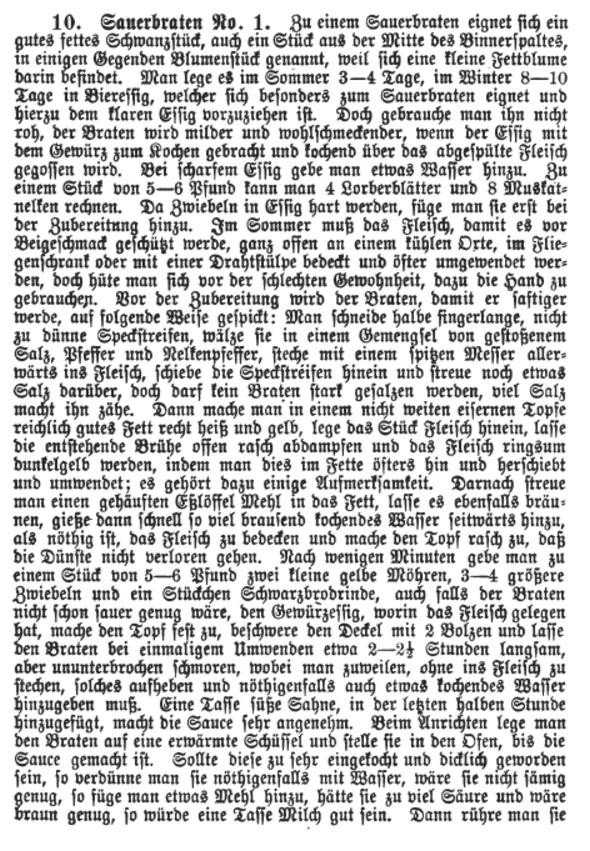
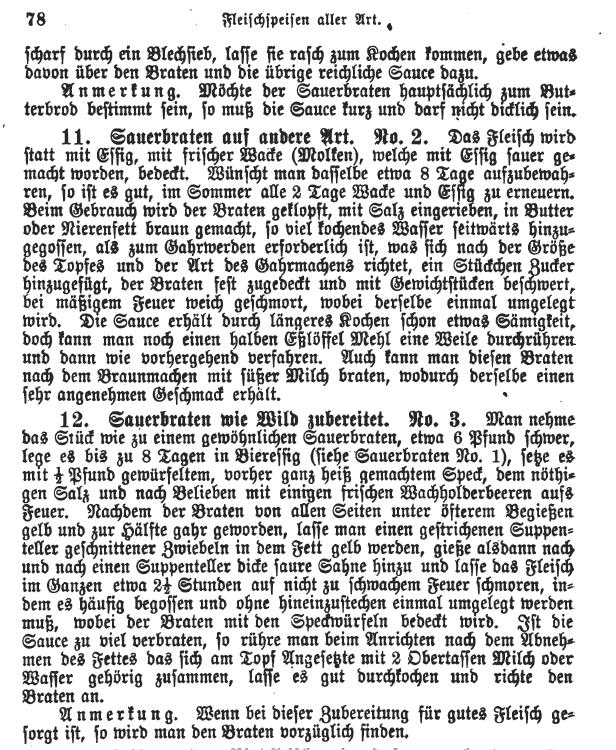
-Davidis, Heennette, Koch-Buch fur die Deutschen in Amerika, 1879, pp.77-78.
Praktisches Kochbuch für die gewöhnliche und feinere Küche, 1897


-pp. 140-141.


-Davidis, Henriette, Praktisches Kochbuch für die gewöhnliche und feinere Küche, 1897, pp 626-7.
Neudecker, 1835
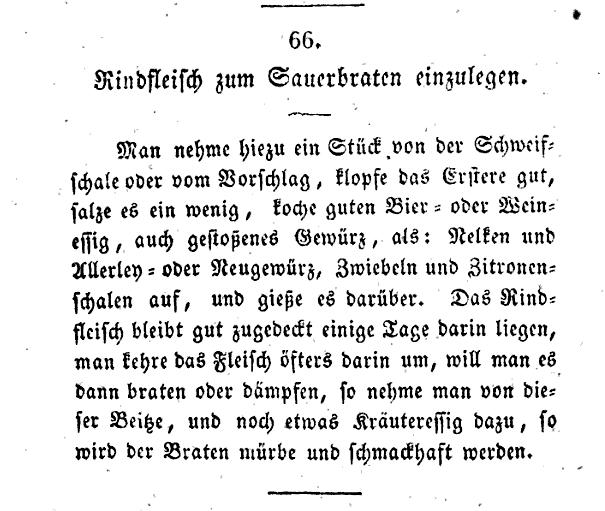
- Neudecker, Maria, A., Die Baierische Köchin in Böhmen als Hausfrau und Wirtschafterin, 1835.
Jungius 1864

-Jungius, L.F., Deutsches Kochbuch für bürgerliche Haushaltungen, 1864, p.88.
Emma Meier, 1898
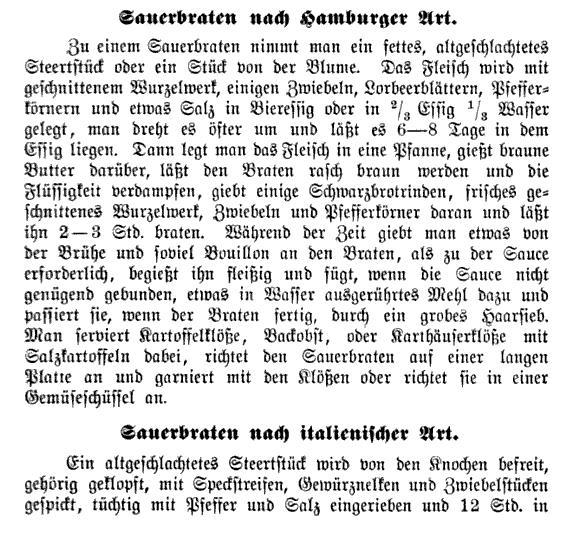
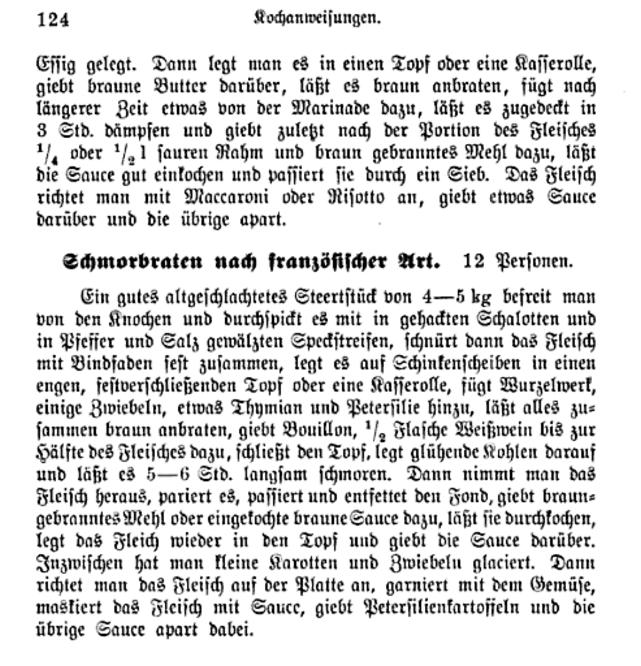
-Meier, Emma, Die moderne Küche, 1898., pp.123-124.
Davidis, Henrietta, Die Hausfrau, 1870
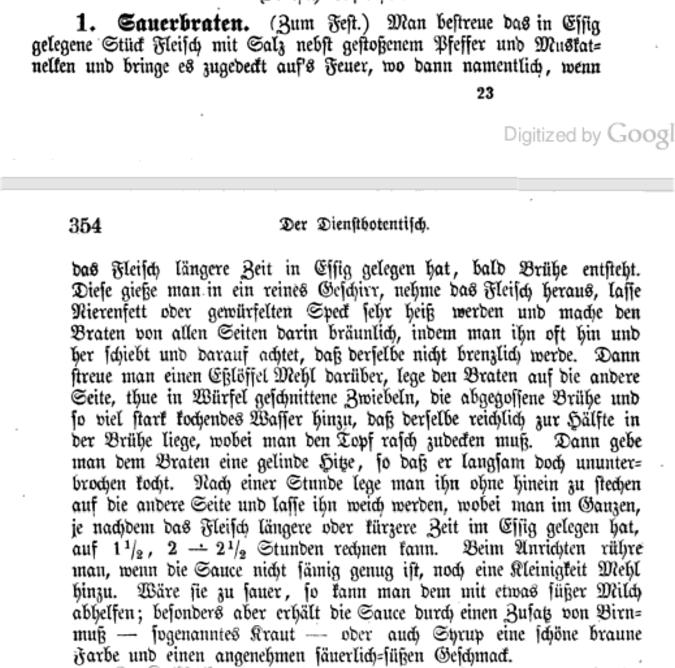
-Davidis, Henrietta, Die Hausfrau, 1870, p. 353-4.
Rheinischer Sauerbraten
(Rhineland Sauerbraten)
The Rhineland Sauerbraten is served with a sweet-sour sauce which has raisins.
1 cup Red Wine Vinegar
1 1/2 cups Water
1/2 teaspoon Black Peppercorns
2 Cloves
5 Juniper Berries
2 Bay Leaves
2 lb Beef Roast (boneless)
4-5 slices Bacon, minced
2 Onions, coarsely chopped
1 Carrot, chopped
1 Celery Stick, chopped
4 tablespoons Oil
Salt
Freshly Ground Pepper
3-4 Lebkuchen
1/2 cup Red Wine
3/4 cup Raisins
Apple Butter, Apple Juice, or Red Current Jelly, to taste
Add water and red wine vinegar to a pot. Bring to a boil. Grind down
peppercorns, cloves, and juniper berries slightly. Add this, as well as
the bay leaves to the boiling liquid. Cook for 2 more minutes, then
remove from heat and allow to cool.
Place the beef roast in a medium-sized bowl. Pour the cooled red wine
vinegar mixture over the beef, so that the beef is completely covered in
liquid. Cover meat tightly and refrigerate for 3 days, rotating meat
daily.
To cook the meat, begin by heating oil in a roasting pot. Add bacon and cook until much of the fat has been rendered.
Remove the beef from the marinade. Pat the meat dry with a cloth or some
papertowels. Season meat with salt and pepper. Place meat in the
roasting pot and sear each side. Add vegetables to the pot with the meat
and allow them cook with the meat.
Pour the marinade through a strainer into a pot. Heat marinade to a boil.
Add about 1 cup of the hot marinade to the meat along with the
Lebkuchen. Cover the pot, reduce the heat to low, and cook the meat for 2
hours. About half way through the cooking, add the red wine.
Once the meat is finished cooking, remove the meat from the pot. Cover
and keep warm. Pour the liquid and vegetables from the pot through a
strainer into a bowl or pot. Return the liquid to the original pot. Mix
in raisins and allow the sauce to cook down, until it is thicker. Season
with salt, pepper, and optionally the apple sauce or red current jelly.
Slice the Sauerbraten and serve with the sauce.
Sauerbraten
3 lb Beef Roast (boneless)
3 cups Water
2 Onions, chopped
1 Carrot, chopped
8 Juniper Berries
5 Whole Allspice Berries (aka Pimento and Jamaica Pepper)*
10 Peppercorns
2 Bay Leaves
4 Cloves
1 tablespoon Salt
1 tablespoon Sugar
2 cups Vinegar (traditionally Red Wine Vinegar is used)
2 tablespoons Butter
2 tablespoons Tomato Paste
1/2 cup Sour Cream
1 slice of Bread (choose a dark bread, like Schwarzbrot)
* If you can't find the whole allspice berries, you can substitute it with 1/2 teaspoon ground (powdered) allspice.
Add water and vinegar to a pot. Add vegetables, spices, salt, and sugar.
Bring to a boil. Allow to boil for 5 minutes, then remove from heat and
cool completely.
Place the beef roast in a medium-sized bowl. Pour the cooled marinade
over the beef, so that the beef is completely covered in liquid. Cover
meat tightly and refrigerate for 3 days, rotating meat daily.
Preheat oven to 350°F (180°C).
To cook the meat, begin by melting the butter in a roasting pot. Remove
the beef from the marinade. Pat the meat dry with a cloth or some
papertowels. Season meat with salt and pepper. Place meat in the
roasting pot and sear each side.
Pour the marinade through a strainer into a pot. Reserve liquid. Add
vegetables (now in the strainer) to the roasting pot. Add the tomato
paste to the roasting pot. Add half of the marinade to the pot and mix
to dissolve the tomato paste.
Cover the pot and cook meat in the oven for 2 hours. During this time,
turn the meat and baste the meat with the liquid in the pot
occasionally. After 1 hour of cooking time, add the bread slice to the
liquid in the pot.
Once the meat is finished cooking, remove the meat from the pot. Cover
and keep warm. Pour the liquid and vegetables from the pot through a
strainer into a bowl or pot. Return the liquid to the original pot and
mix in the sour cream.
Season with sauce with salt and pepper.
Slice the Sauerbraten and serve immediately with the sauce.
German American Cookbook, 1897
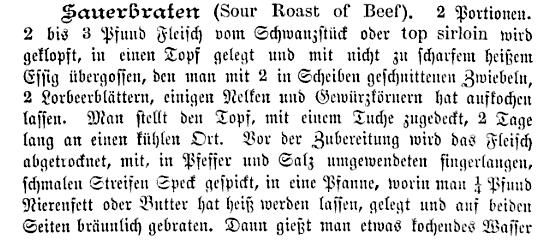
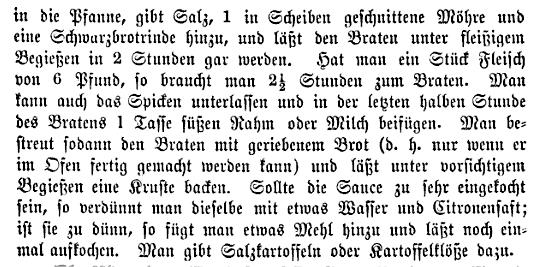
-Schreyer, Woldemar, German American Cookbook, 1897, p.85.
To return to the top click here
|

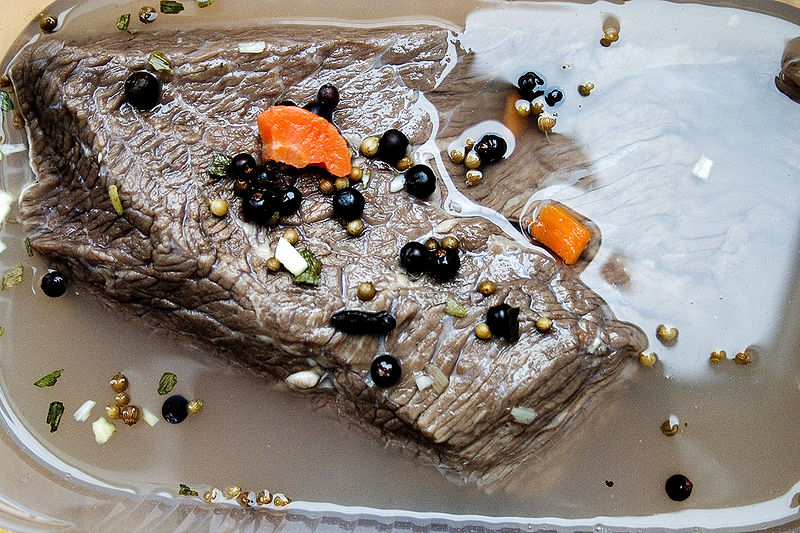
 brät
brät n)
n)  r, from Old High German) + Braten, roast meat (from Middle High German br
r, from Old High German) + Braten, roast meat (from Middle High German br te, edible meat, from Old High German br
te, edible meat, from Old High German br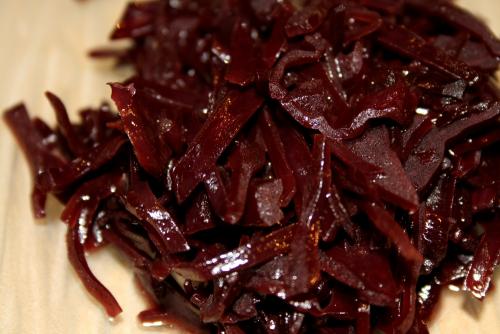
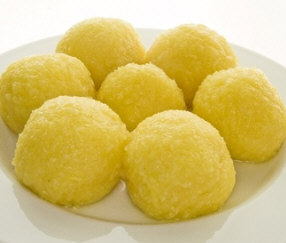
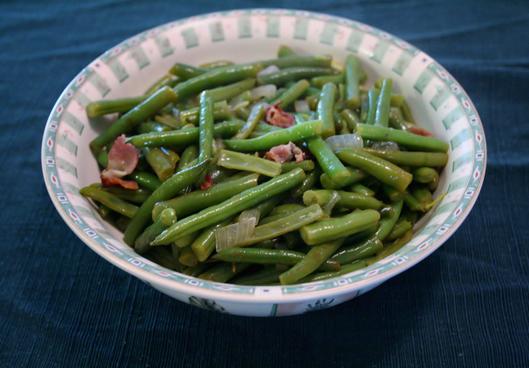
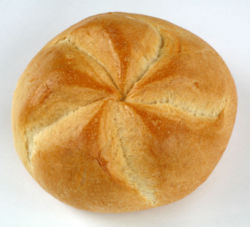
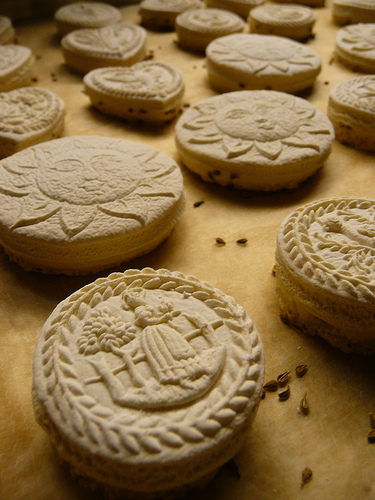
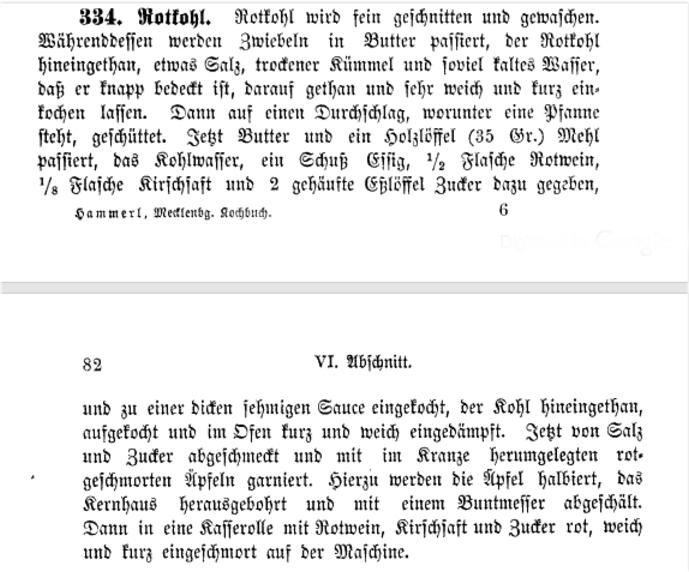
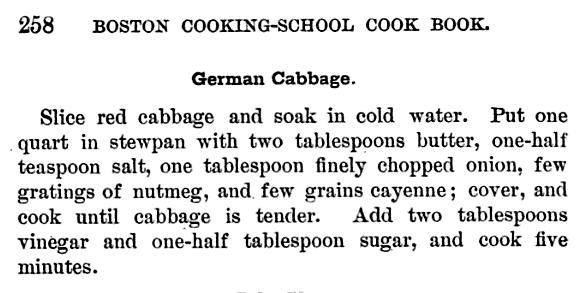
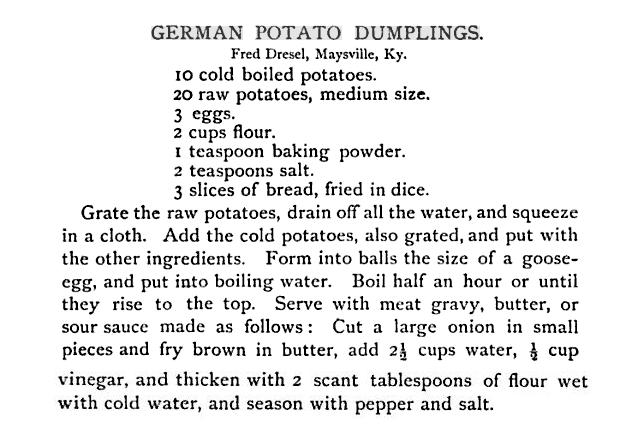


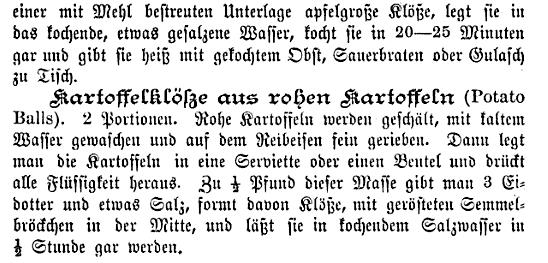

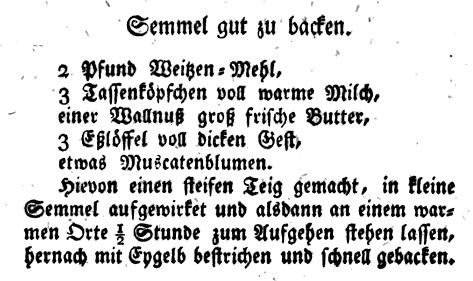
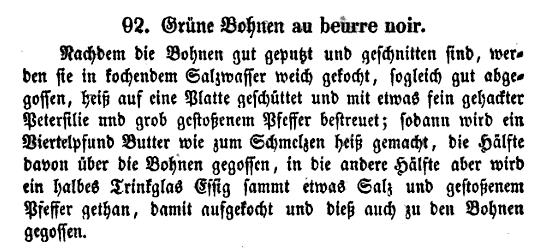
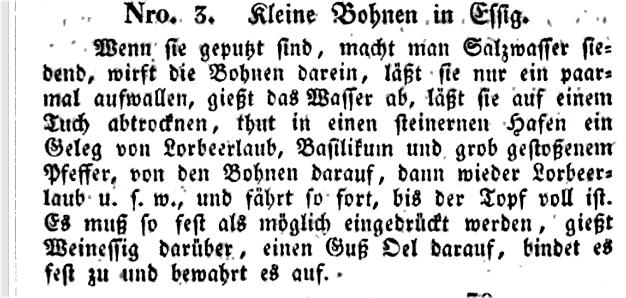
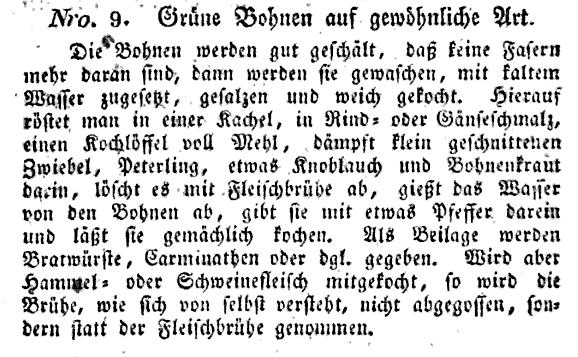
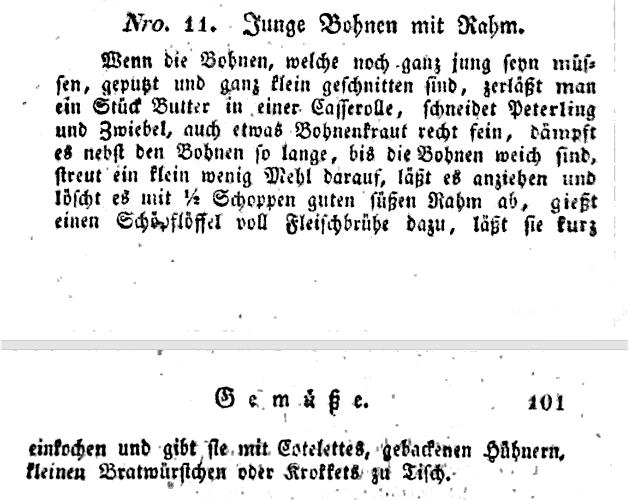


 Historically Correct Traditional Recipes
Historically Correct Traditional Recipes












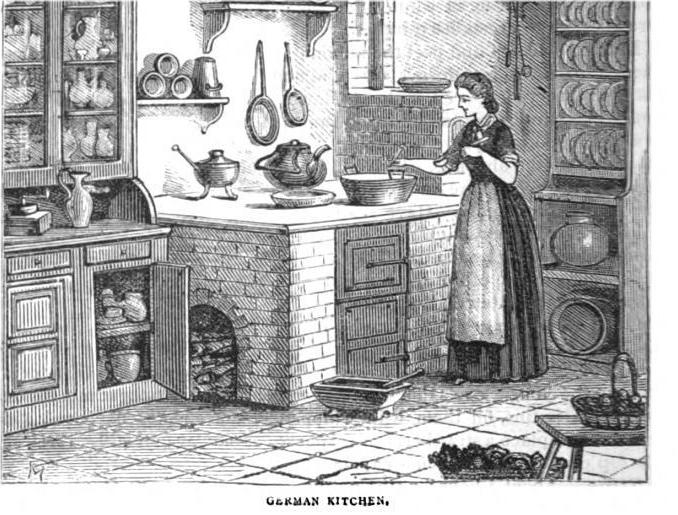 The German
The German 